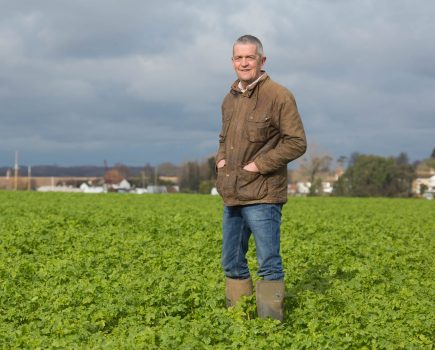By Martin Lines
Like many, we’re coming out of winter with the already-planted crops in a very mixed condition – we don’t have a single field with uniform establishment or condition of crops. The recent weather has certainly taken a toll on some of them and has left us with management problems to consider.
Some areas will have to be replaced entirely, and others will require a lot of help to achieve a profitable return. We usually have a rough nutrient management plan for the season ahead, selecting a representative range of fields to conduct some soil nitrogen testing which gives us a base level of nitrogen available in the soil. We then follow this up with tissue testing and handheld sap analysis.
The challenge we don’t have this year, is working out the right amount to fertiliser to apply to the right areas of fields in order to meet our crop potential. With the new SFI standard coming later in the year, we’ll have the opportunity to invest in more.
With the reduction in autumn planting and the increased cost of spring seed and inputs, the next few months’ weather will be critical to our crops if we’re to achieve profitable yields. Now the BPS has been decoupled, focusing on fixed and variable production costs will be very important.
For some, delivering more environmental benefits and using herbal lays and legume fallow options will give a better return on investment, reducing variable costs and helping to build soil fertility at the same time. This will have to be kept under review as our farming systems change.
This time of change and adjustment is making some farmers and contractors refocus their businesses and what they produce. Food production and food security is important, but it’s not the responsibility of farmers. What is our responsibility is maintaining as much profitability as possible now and for the long term.
The use of fossil fuel-based fertilisers and the negative effects these have on carbon footprints will become an increased focus in the years ahead. There is also a spotlight on urea fertiliser and its effect on air quality – not just where it’s used, but also the drift in neighbouring towns and cities.
The government is taking a close look at urea fertiliser use. You might remember that Defra ran a consultation to reduce ammonia emissions from urea fertilisers? In response, an industry consortium proposed an alternative approach, to be delivered through the Red Tractor Farm Assurance scheme.
These new Red Tractor standards will require scheme members to restrict use of untreated urea from 15 January to the end of March each year, only using treated urea fertilisers after March to reduce ammonia emissions. Alternatively, you can apply them in line with guidance from FACTS-trained advisers throughout the year.
The effectiveness of the scheme will be monitored with regulation being introduced if the scheme doesn’t achieve the ammonia reductions required. When the scheme’s restrictions are introduced, they’ll be related to the use of ammonia inhibitors rather than a complete ban – it’ll be the responsibility of all farmers to abide by the rules and only apply after March with the correct inhibitor.
If air quality doesn’t improve, or farmers don’t abide by the spreading restrictions of untreated urea, there’s a real risk that Defra will put in place further restrictions.
To try to reduce our own impact, we’ve been using various biostimulants and other products as a replacement for some of our fossil fuel-based fertiliser. This has produced some interesting data and cost differences. It’s only by trying things on our farms that we can see the benefits (or shortcomings) of these products.
If our industry is to reach the NFU’s goal of net zero by 2040, we’ll have to rapidly change the way we use fertiliser and other fossil fuel-based products. Speaking to and meeting many farmers across country, I’m always inspired by what many are doing – helping to increase biodiversity and improve soil health, reducing their carbon footprints and delivering climate mitigation solutions.
Many of these improvements are currently being funded by and will be funded by public and private finance in the years to come, giving us access to markets in the future and helping to work towards a sustainable future for farmers and farming.
This article was taken from the latest issue of CPM. For more articles like this, subscribe here.
Sign up for Crop Production Magazine’s FREE e-newsletter here.




